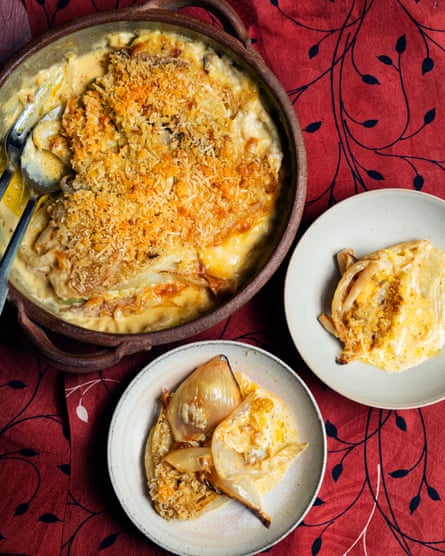It is the season of cobwebs, trailing across the vegetable gardens and allotments, glistening with dew, each drop sparkling in the early morning light. They hang between the bean sticks and the browning vines of pumpkins. I baked my first squash of the season this week, a plump, smooth-skinned butternut, a little fatter than most. I basted its flesh, firm and orange-bright, with a paste of sweet honey and dark soy sauce and seasoned it with the warmth of ground Aleppo pepper and garlic.
The butternut – sticky, hot and sweet – glowed brightly on its mound of steamed white rice. There was no sauce as such, and neither does there need to be, just a sprinkling of roasted sesame oil as it was served. We followed it with the very last of the plums, stewed with a little sugar and a cinnamon stick.
The sweeping up of falling leaves has started in earnest and, with it, the need to come in for a warming supper from the oven. A gratin, vegetables baked slowly in cream with a crisp crust of breadcrumbs and cheese, fitted the bill. A good-natured recipe that won’t mind sitting quietly in the switched-off oven until we are ready.
We mopped the aniseed-scented cream from our plates with bread, but a more substantial answer could have been bulgur wheat warmed with vegetable stock or a mound of steamed freekeh, the roasted and steamed wheat with its gently smoky back note. Another time, this might make a good side dish for grilled chicken thighs, the juices from the chicken mingling with the creamy ones of the gratin.
Pumpkin, soy and honey
It might seem odd to add further sweetness to the flesh of a pumpkin or squash by the introduction of honey, but it works when mixed with the pungent umami of the soy and the heat from the ground chilli. I used Aleppo pepper, but just use whatever you have. A smoky paprika might be good here, too, providing a more subtle warmth. For a vegan version, you could substitute agave or date syrup for the honey.
Serves 4. Ready in 1.5 hours
butternut squash or pumpkin 800g-1kg
garlic 3 large cloves
ginger 50g
Aleppo pepper 1-2 tsp
honey 6 tbsp
soy sauce 5 tbsp
groundnut oil 1 tbsp
sesame seeds 2 tsp
To serve:
steamed white basmati rice,
roasted sesame oil and orange slices
Slice the butternut squash in half from stalk to tip, then scoop out and discard the seeds and fibres from the core. There is no need to peel a butternut, though you can if you wish. If you are using a pumpkin, then remove the tough outer skin with a vegetable peeler or large knife. Cut into slices about half a centimetre thick and place them on a large baking sheet or in a roasting tin. It is unlikely you will manage to get them in single layer, but try to keep the pieces as separate as you can.
Preheat the oven to 200C/gas mark 6. Peel the garlic, then crush to a paste with a pinch of salt, using a pestle and mortar. Peel the ginger, then grate to a purée, using a fine-tooth grater, into the garlic. Mix in the Aleppo pepper, then stir in the honey, soy sauce and oil. You should have a sticky, glossy dark dressing.
Pour the honey and soy mixture over the squash and turn it over and over so it is fairly evenly coated. (If you can bear it, this is much more easily done using your hands than with a spoon.) Bake for 25 minutes, remove briefly from the oven and turn the pieces over carefully with palette knife. Scatter with the sesame seeds and return to the oven for a further 15 minutes or until the flesh is soft and glossy. There will be no sauce as such, just shiny, sticky slices of butternut.
Remove from the oven and let it rest for a couple of minutes, then turn the golden moons of butternut carefully, coating them with the sticky dressing, then pile on top of the steamed rice with a few orange slices and trickle with a little roasted sesame oil.
Fennel gratin with anchovies

It is worth taking care to slice the fennel thinly. Apart from taking less time to cook, it harmonises better with the sauce. Baking fennel tends to soften harsh aniseed notes present in the raw vegetable, notes that I have further mellowed with a shot of Pernod which you can add or not as the fancy takes you. Vegetarians may like to omit the anchovies.
Serves 4. Ready in 1 hour
fennel 750g
olive oil
white bread 45g, fresh
shallots 2, large
Pernod 2-3 tbsp
anchovy fillets 8
double cream 250ml
parmesan 2 tbsp, grated
Preheat the oven to 200C/gas mark 6. Trim the fennel, then slice into pieces not much thicker than a £1 coin. (The thicker you slice them, the longer they will take to cook.) Warm a thin layer of olive oil, about 3 tbsp in an ovenproof dish or frying pan, place the fennel in the oil, then cover with a lid and cook over a moderate heat for a good 15 minutes until they start to soften.
Reduce the bread to fine crumbs. Peel and thickly slice the shallots and scatter them among the fennel and continue cooking for a few minutes. Pour the Pernod into the pan and let it bubble for a couple of minutes, then place the anchovies among the fennel. Season the cream with finely ground black pepper (no salt) and pour it over the vegetables.
Scatter the surface with the breadcrumbs and the grated parmesan and bake in the preheated oven until the crumbs and parmesan are crisp and the cream is bubbling around the edges, about 25 minutes. Let it settle for a few minutes before serving.
Follow Nigel on Instagram @NigelSlater
